It’s that time of the year when our freezers are probably seeing a lot of action as sauces, soups, stock, and all kinds of seasonal bounties start making their way from the garden to the kitchen to—eventually—this winter’s dinner table.
A lack of space in my own freezer means I’ve skipped my old standby of freezing whole cherry tomatoes in favor of tomato purees that are ready to spice up for homemade marinara sauce, soup, and ketchup.
(Here’s my favorite recipe for homemade tomato sauce—no blanching, peeling, or seeding required!)
And that brings up a question I’m often asked: What’s the most ideal way to store these liquids in the freezer?
Disclosure: If you shop from my article or make a purchase through one of my links, I may receive commissions on some of the products I recommend.
For years I used the flat-pack baggie method: Fill a few zip-top freezer bags with liquid, squeeze all the excess air out, then lay them flat and stack them in the freezer.
(Some marketing geniuses felt our pain of freezer bags getting all misshapen and toppling over, and created this contraption for stacking them perfectly flat, as well as this product which lets you freeze bags upright, making use of vertical storage.)
While that tested-and-true method is pretty handy in the kitchen, these days I find myself reaching for my mason jars more and more.
They’re easy to fill, easy to thaw, free of leaks, and useful for storing leftover liquids in the fridge (without the need to decant into a separate container).
Related: 9 Updated Canning Tips and Tricks for Modern-Day Home Canning
If you’re trying to avoid excessive use of plastic in the home, glass mason jars are a great reusable option that you likely already have around. You can freeze liquids in mason jars and store them for several months in the freezer.
But! If you aren’t careful, the glass may crack or shatter as the liquids solidify.
So here’s a quick tip for making sure that doesn’t happen…
Use only straight-sided mason jars and fill them to the freeze-fill line.
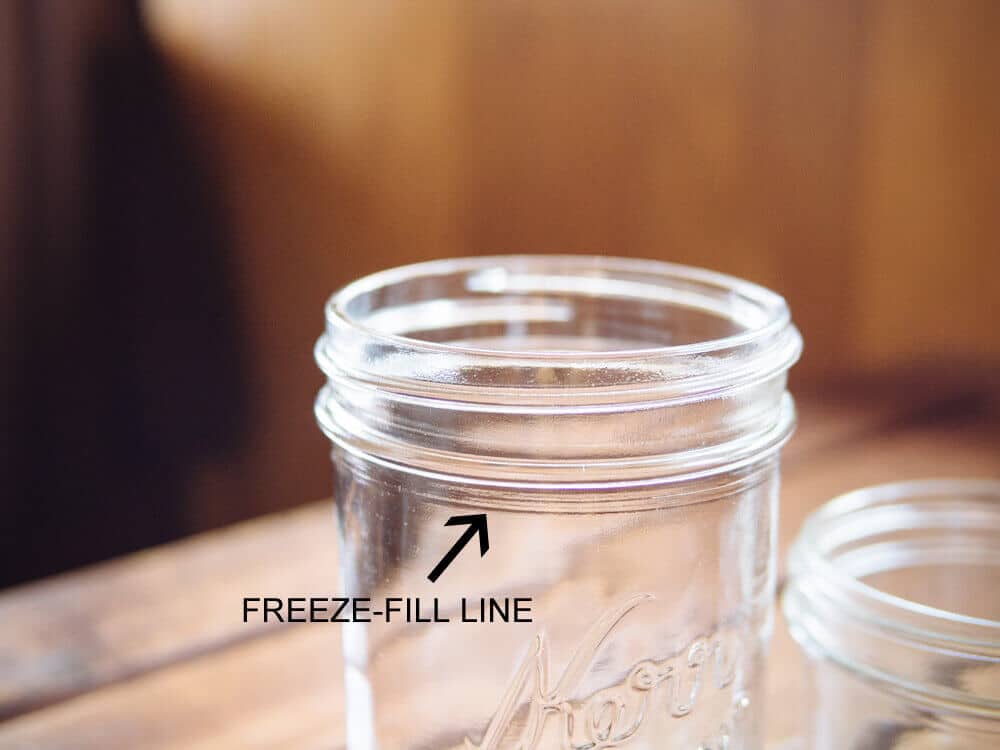
On Ball- and Kerr-branded jars (made by the same company, for which I was a Newell Brands ambassador), the freeze-fill line is a thin line found just below the threads, about an inch from the rim.
Some (though not all) of their jars even have “For Freezing—Fill Here” embossed on the line.
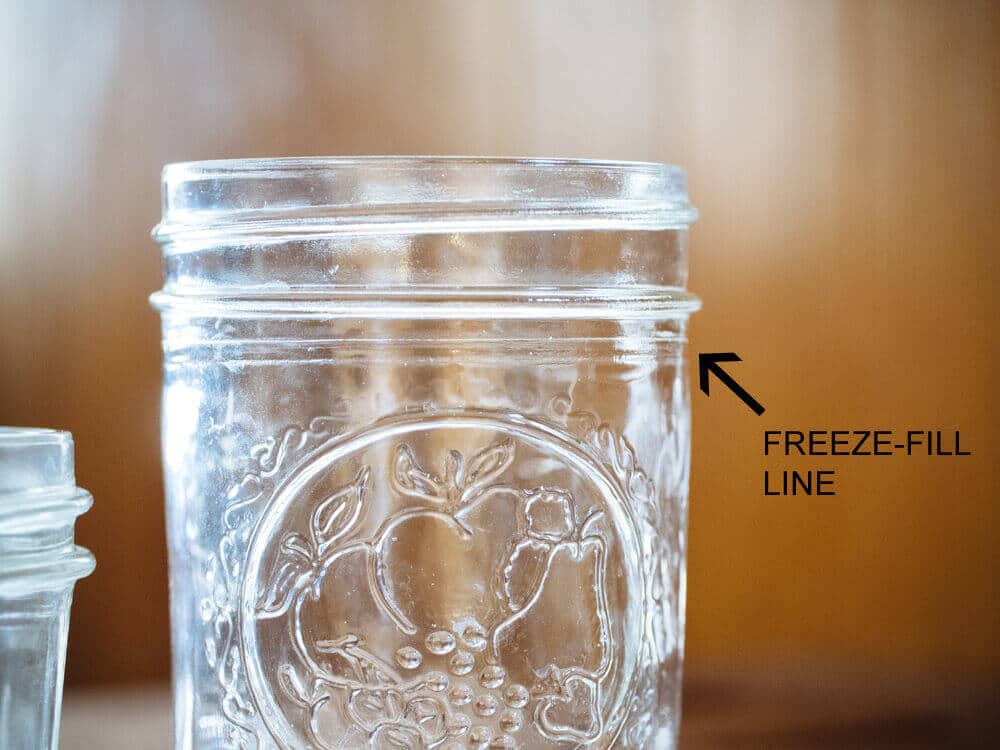
The purpose of the freeze-fill line is to indicate the maximum amount of liquid you can safely store in your jar without risking a cracked jar when the contents freeze and expand.
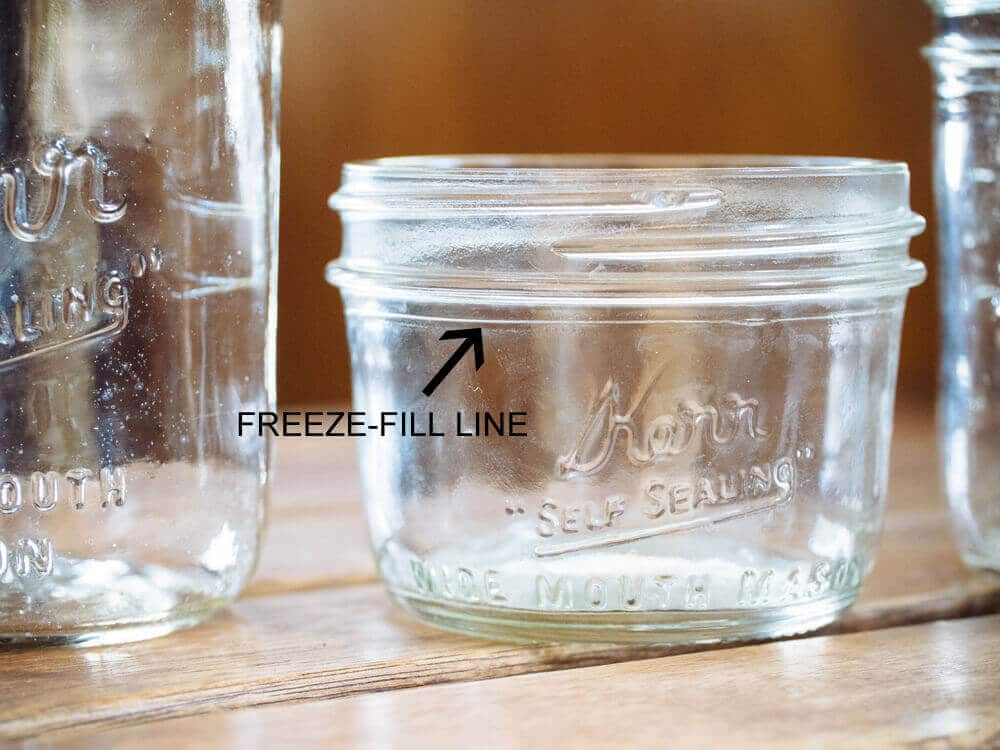
Jars that are best suited for freezing liquids include:
- Regular-mouth jelly jar (4 ounces)
- Regular-mouth jelly jar (8 ounces)
- Regular-mouth jelly jar (12 ounces)
- Regular-mouth half-pint (8 ounces)
- Wide-mouth pint (16 ounces)
- Wide-mouth pint-and-a-half (24 ounces)
Happen to notice a common feature among these jars? They all have straight sides.
Jars that have shoulders, such as regular- and wide-mouth quarts, are not suitable for freezing liquids unless you fill them to no more than 1 inch BELOW the shoulders.
This isn’t the most efficient use of space, since only 2 1/2 to 3 cups of liquid will fit—but in a pinch, it’ll work.
I’ve successfully frozen liquids in quart jars by making sure I leave plenty of headspace (about 3 inches) for the liquids to expand upward.
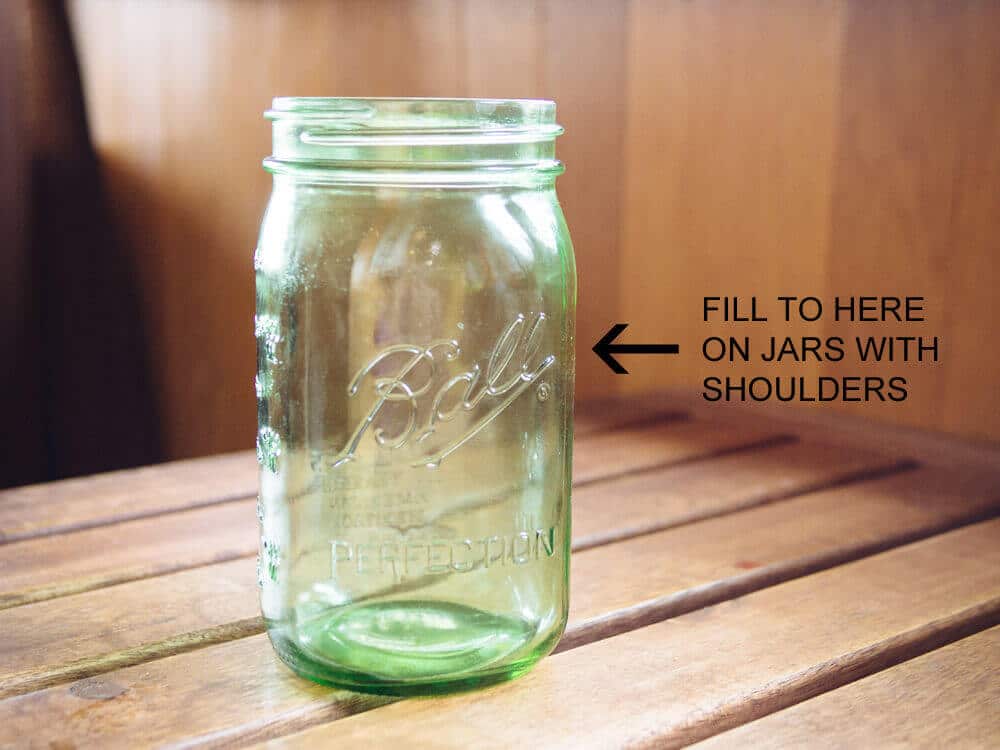
If you aren’t comfortable with this, but like the convenience of jars and need to store more than jelly jars allow, you can also try plastic freezer jars. (These come in different sizes, depending on how much liquid you need to store.)
Here are a few things to keep in mind to reduce the risk of leaks and breakage with glass mason jars:
- Use one-piece plastic lids when freezing your jars (not the metal rings and lids that came with them). Not only does this help you open jars more easily, but you can wash them multiple times without worrying about rusting. (I like these ones because they’re leakproof.)
- Glass can crack under thermal shock. Always cool liquids to room temperature before filling your jars. Alternatively, run your jars in the dishwasher with a heated drying cycle right before filling them with hot liquids.
- Place your jars inside a cardboard box or other shatter-proof container before putting them in the freezer. This keeps other items from knocking into them, especially if you use a chest freezer. A good sturdy box also allows you to stack other items on top to maximize storage. (These cardboard boxes with divided compartments are perfectly sized for pint and quart jars.)
- Use silicone sleeves to protect the glass. To reduce the chances of other items in the freezer knocking against your jars (and possibly causing hairline cracks), use silicone sleeves like these ones for 24-ounce jars (or these ones for 32-ounce jars).
- Don’t expose your frozen jars to sudden heat. Defrost them in the fridge, or out on the counter at room temperature.
What are some of your favorite foods to stash in the freezer?
This post updated from an article that originally appeared on July 24, 2017.
View the Web Story on how to freeze liquids in mason jars.


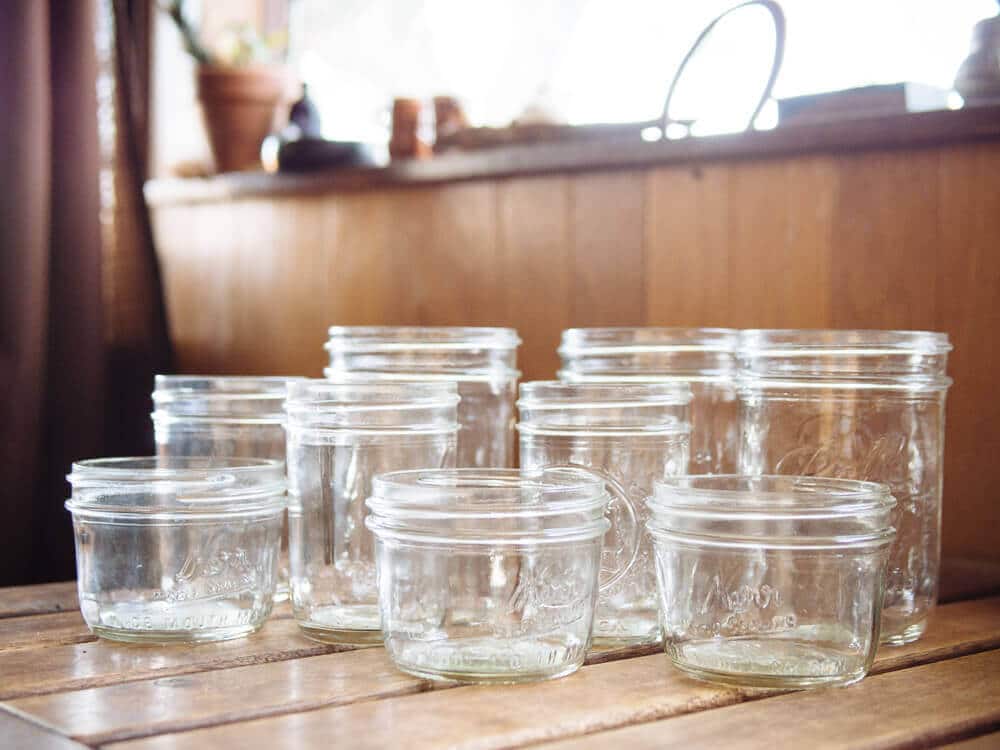













great & detailed info Linda! especially about the hidden freeze line, straight sides, and initially freezing without the lids on larger containers.
having to make food ahead for my ailing dad. whatever isnt finished soon enough gets put into the freezer.
just switched to smaller canning jars because the similarly sized pyrex & anchor hocking werent doing as well; although the lid is secure before going into the freezer, it’s loose after it freezes.
The link for JarBox Protectors goes to a product that does not look like an egg carton for jars.
I saw that too.
Yay…happy to hear that I don’t have to use plastic! Thanks for the tips!
I bought organic juices in glass jars the shelflife they say to use within two days after opening and refrigerating.
Can you freeze the juice after opening a large bottle so you do not have to consume it within two days?
Yes you can freeze juices after opening, but make sure the liquid level is below the shoulders of the jar as recommended in this article.
Have you ever frozen milk in a mason jar?
I haven’t because we just drink it fresh at home, but milk freezes just like any other liquid.
I really appreciate this idea of freezing mason jars. I didn’t know That I must not fill to the shoulder, I even filled to the rim. Since I cracked one bottle, I’ve been afraid to do it again. What a big help you are. Thanks a lot. I’ll try again the fight way.
This article was so helpful. Thank you
This probably a dumb question, but I make my sauce with meatballs & sausages. Is it ok to add these to the jars as well? Or if i end up using freezer bags, is it ok to add these too?
I would not can your sauce with meat. It would extend the processing time with a pressure cooker. That extra time of processing might not give you the best quality tomato sauce. Freezing it with meat is okay though. If it was me, I would add my meat the day I cook the sauce. You could process your meat separately, which would create more space in your freezer.
Alan, I like your idea. After cracking a jar this week, I was also thinking about freezing in “layers”. In other words, fill one-third full, freeze and then repeat twice (still leaving the proper head room). I’ll let you all know how that turns out.
I am planning to freeze some apple pie filling in glass mason jars and all of the info in this articles and these comments are invaluable. A friend of mine, who freezes a lot in jars, told me another tip. Freeze without the lids and when the product is frozen, put the lids on and replace in the freezer. She says this has worked for her all of her life.
Voila! thanks for that tip. Pun intended.
Oh and the Jarboxes are super high priced on Amazon. Will look for another source.
Target or Walmart
Will this process work for Apple Butter?
Yes, I recommend taking the same precautions for freezing apple butter. (Though most of what I’ve seen/made is usually thick enough to not expand as much as liquid.)
I froze in wide mouth and narrow mouth jars (quarts usually, occasionally half gallons and pints) for years with only a cracked jar or two. I left good head room, capped them and FROZE THEM ON THEIR SIDE to avoid the break at the shoulder problem. Then seemingly out of the blue, I lost a few in a row which bummed me out.
My googling led me to someone telling me that if the top of the jar wasn’t absolutely dry and clean when I lidded my jars that that could cause a crack when the contents froze.
That’s when I switched to 24 oz wide mouths for freezing. I fill to fill line, freeze without lids, then lid them the next day. I haven’t lost another jar in over five years.
The 24s are a more efficient use of space because you get as much or more product in them than you do in a quart jar you can’t fill to the fill line
Aside– I just visited friends who have soup frozen in jars…to the top! I could see one of the poor widemouths was cracked so I took it out, set it in a pan to thaw so I could show my friend and share my useful tip about the likely cause being something on the rim. To my horror, she decanted the soup into another jar!!! Not completely calmly, I explained that you can’t know for sure that there isn’t a glass shard in that. She argued. I said …I hope you don’t kill yourself or any of our loved ones including me!
Oh yikes, I hope your friend realizes how sketchy that is!
I also agree that those pint-and-a-half jars are great for freezing!
I will admit to doing that too but I always scrape the frozen soup on the outside especially where the cracks were and then rinse it. I am assuming the cracks happen at the frozen stage??????
Thank you Maura!
“That’s when I switched to 24 oz wide mouths for freezing. I fill to fill line, freeze without lids, then lid them the next day. I haven’t lost another jar in over five years.”
Freezing with or without lids is what I needed to know.
JJ
“
Thanks, that was great. Awesome that a fill line is built in.
Just bought my first jars, wanted to freeze homemade broth to make soup. Wanted to use quart size and understand about not filling to much because of breakage, and how quart size not good use because you can’t fill it up full with liquid, so my thought is to fill as you say, I think it was about 2/3 rds full, freeze, and then fill with veggies after liquid frozen. Just thinking outside the box, hope I don’t have any issues with freezing any jars.